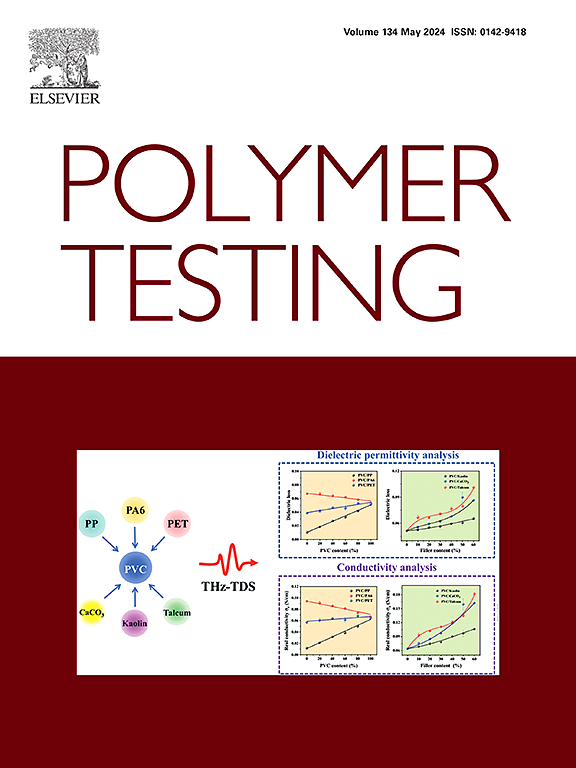Testing of polymeric battery separators using air-coupled, high-frequency and wideband ultrasonic pulses
IF 5
2区 材料科学
Q1 MATERIALS SCIENCE, CHARACTERIZATION & TESTING
引用次数: 0
Abstract
Separator membranes are one of the components in batteries and, although being a passive component, they may strongly affect both battery performance and security. Hence, effective control of both its main properties and their variability are critical issues for the battery industry. This work proposes testing these membranes by the measurement of the spectra of the ultrasonic transmission coefficient (magnitude and phase) using high-frequency and wideband air-coupled ultrasonic pulses. This non-conventional ultrasonic technique for materials testing offers several advantages: it is completely contactless and non-invasive, it is very fast, and it has the potential to be deployed in the fabrication line to test the 100 % of the production in real time. This work shows that it is possible: a) to propagate high-frequency, wideband air-coupled ultrasonic pulses in the frequency range 0.15–2.4 MHz in battery separators, b) to obtain the transmission coefficient spectra, both magnitude and phase; c) to theoretically model this propagation and the transmission coefficient spectra in thin films and then d) to solve the inverse problem to extract some separator properties of interest. The obtained properties depend on the theoretical model use to describe the propagation. For separators with porosity <60 % and pore size big enough (approximately <1 μm for the separators studied here), effective medium approach can be successfully used, while for the other cases, the porous nature of the separator has to be taken into account and the Biot's theory is used.
使用空气耦合、高频和宽带超声脉冲测试聚合物电池分离器
隔膜是电池的一个组成部分,虽然是一个被动的组成部分,但它可能会严重影响电池的性能和安全性。因此,有效控制其主要特性及其可变性是电池工业的关键问题。这项工作建议通过使用高频和宽带空气耦合超声脉冲测量超声波透射系数(幅度和相位)的光谱来测试这些膜。这种用于材料测试的非常规超声技术有几个优点:它是完全非接触式和非侵入性的,速度非常快,并且有可能部署在生产线上,实时测试100%的产品。研究表明:a)在电池分离器中传播频率范围为0.15 ~ 2.4 MHz的高频宽带空气耦合超声脉冲是可能的;b)获得传输系数谱,包括幅值和相位;C)理论模拟这种传播和透射系数光谱在薄膜中,然后d)求解反问题,以提取一些感兴趣的分离器性质。所获得的性质取决于用来描述传播的理论模型。对于孔隙率为60%且孔径足够大的分离器(本文所研究的分离器孔径约为1 μm),可以成功地采用有效介质法,而对于其他情况,则必须考虑分离器的多孔性,并使用Biot理论。
本文章由计算机程序翻译,如有差异,请以英文原文为准。
求助全文
约1分钟内获得全文
求助全文
来源期刊

Polymer Testing
工程技术-材料科学:表征与测试
CiteScore
10.70
自引率
5.90%
发文量
328
审稿时长
44 days
期刊介绍:
Polymer Testing focuses on the testing, analysis and characterization of polymer materials, including both synthetic and natural or biobased polymers. Novel testing methods and the testing of novel polymeric materials in bulk, solution and dispersion is covered. In addition, we welcome the submission of the testing of polymeric materials for a wide range of applications and industrial products as well as nanoscale characterization.
The scope includes but is not limited to the following main topics:
Novel testing methods and Chemical analysis
• mechanical, thermal, electrical, chemical, imaging, spectroscopy, scattering and rheology
Physical properties and behaviour of novel polymer systems
• nanoscale properties, morphology, transport properties
Degradation and recycling of polymeric materials when combined with novel testing or characterization methods
• degradation, biodegradation, ageing and fire retardancy
Modelling and Simulation work will be only considered when it is linked to new or previously published experimental results.
 求助内容:
求助内容: 应助结果提醒方式:
应助结果提醒方式:


